Pinterest is one of the best pre-commerce platforms, it’s where shoppers plan and dream before they buy. The Pinterest funnel follows four stages: Inspiration → Save → Research → Buy.
Merchants can win by:
“You see, but you do not observe.” Sherlock says it in A Scandal in Belgravia, not to be mean (well… maybe a little), but to make a point: the clues are there, you’re just not paying attention.

That’s Pinterest for most merchants.
They see the pretty pictures, the mood boards, the recipe hacks, but they don’t observe what’s really happening:
It’s not the “buy now” moment. It’s more like a blueprint moment, when customers are quietly collecting ideas, pinning products, and piecing together the version of their life they want to buy into.
And here’s the thing, most of them are not doom scrolling on Pinterest.
📌 93% of Pinners are here with a plan in mind.
📌 96% of searches are unbranded, compare that to Google, where roughly 45.7% of searches are branded. So, on Pinterest your product has a real shot even if they’ve never heard of you before.
📌 80% of weekly Pinners say that they feel inspired by the shopping experience on Pinterest.
📌 And clearly, it’s working, Pinterest pulled in $1.15 billion in revenue in Q4 of 2024 alone.
That’s why I call Pinterest the pre-commerce platform, the one place you can sneak onto the shortlist before they even open a cart, before they compare prices, before they know which brand they’ll pick.
Imagine your product quietly sitting on their “Dream Kitchen 2025” board for months, alongside colors, textures, aesthetics, and moods they’ve been creating and painting it like an art project. By the time they’re ready to buy, you’re not just an option, you’re the vision they’ve been building towards.
And hey! we’ve already covered the basics in our earlier piece, “What Merchants Don’t Realize About Pinterest – 93% of Pinners Plan to Purchase.” If you haven’t read it yet, it’s worth a quick scroll.
So, here’s the plan, give me the next eight, maybe nine minutes tops, and I’ll walk you through exactly how this works: the how, the why, the when, the where, and everything in between.
By the end, you’ll know how to go from “just another pin” to “the product they can’t picture their life without.” Ready?
Pinterest isn’t a straight “see → click → buy” platform.
It’s a slow burn funnel where customers move through four clear stages:
Inspiration → Save → Research → Buy
Your job? Not to rush them, just sit back and relax, but make sure you’re right there at every stage so, by the time they’re ready to buy, you’re the obvious choice.
This is where they start building the vision. They’re searching things like “Rustic farmhouse interiors”, “warm rustic living room”, or “holiday outfits 2025”.
They’re not in the buying mode, yet. But they’re laying the groundwork for it.
And this stage is powerful: according to Pinterest, 85% of weekly Pinners have bought something based on pins they’ve seen from brands.
Merchant move:
Be part of that first vision. That means:
Every year, Pinterest releases an annual trend report based on billions of searches, highlighting themes likely to grow in the year ahead, and 80% of these predictions have proven accurate.
Example: Wayfair, the American e-commerce home brand, got their hands on this trend early with Cherry Coded-inspired DIY videos and posts. They subtly incorporated peel-and-stick wallpaper into trending aesthetics.
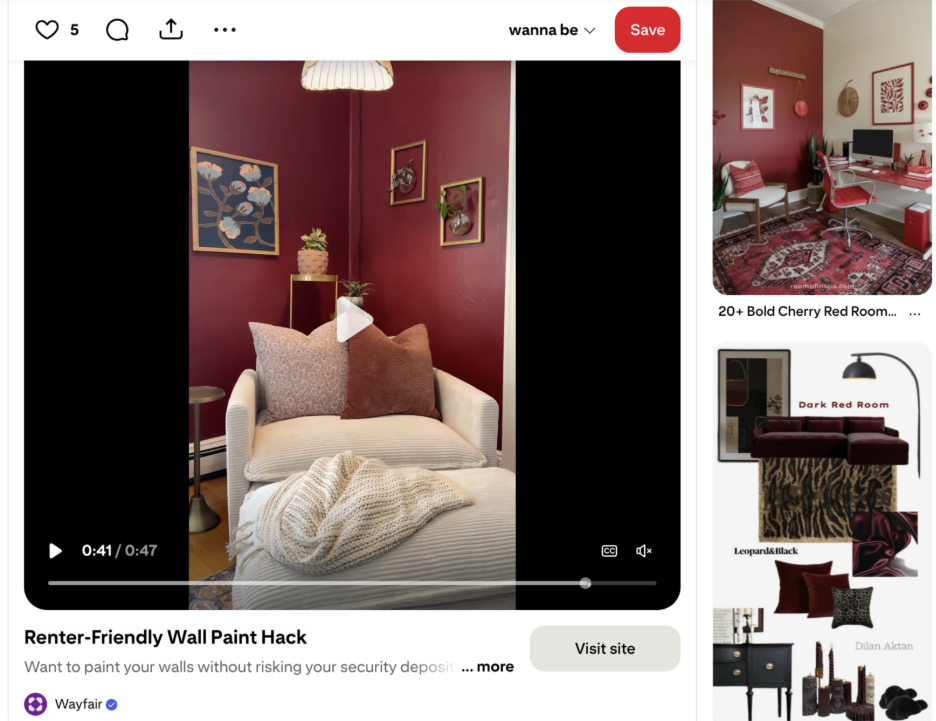
Example: Target leans into Pinterest’s seasonal planning. They went from “back to college” pins straight into Halloween DIYs, months before October, keeping ahead of what shoppers will search next.
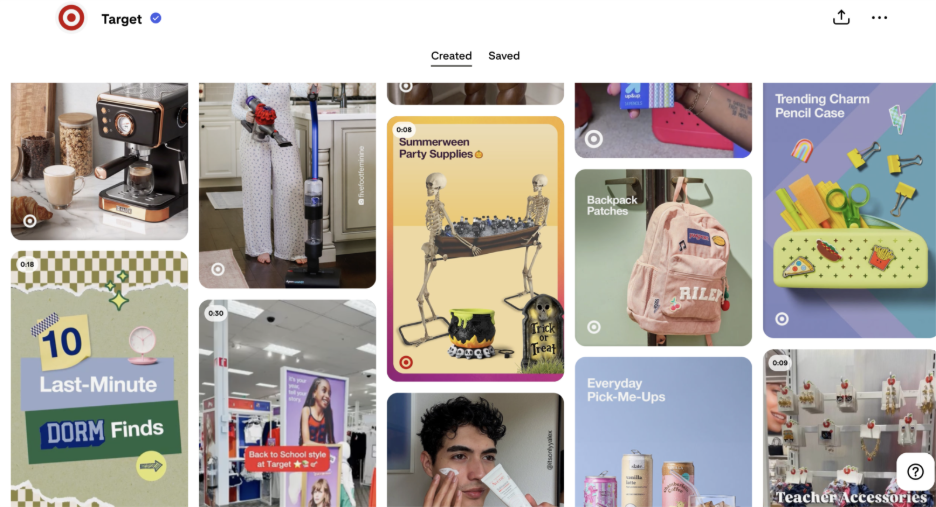
Well, this is the moment your product goes from “That’s nice” to “I want this later.”
When they save a pin, they’re putting it in a private or public board that acts like a future shopping list.
Why it matters: Saved pins get revisited multiple times before purchase. And if you’re on that board, you’re essentially pre-qualified as a contender.
💡 Pro Tip: Pinterest’s Shop the Look feature lets you tag multiple products in a single image so people can click and shop each item directly from the pin.
Merchant move (Etsy real-time example):
Etsy nails this with a combination of Collection Pins and Shop the Look features.
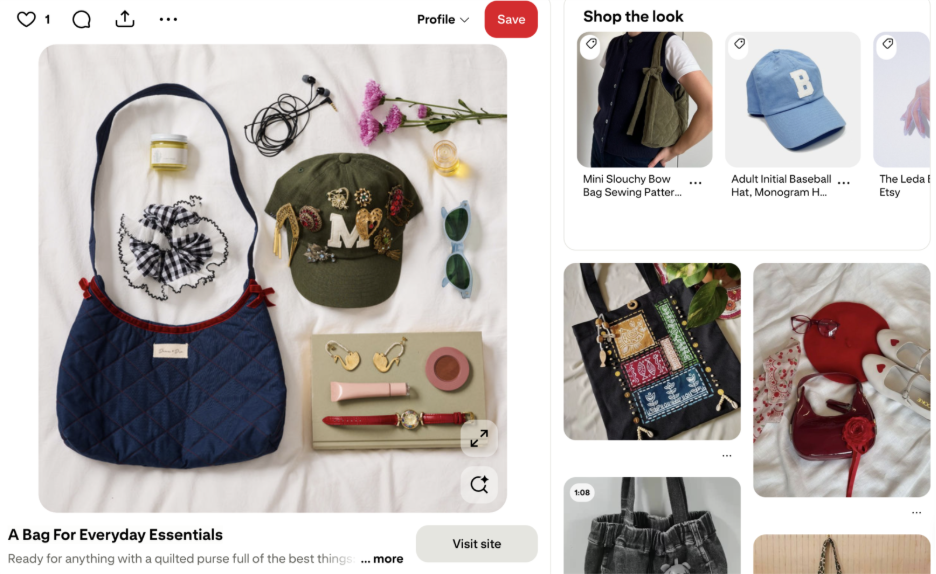
In the above pin, they’ve styled a quilted navy bag alongside a matching scrunchie, embroidered cap, statement earrings, watch, and makeup, creating a “bag for everyday essentials” vibe.
Here’s what’s working:
- Show color and style variations in one visual, “the same dress in three shades” or “or the same cookware in multiple finishes” so they feel they’re choosing their favorite, not hunting for options.
Example: Le Creuset, the French premium cookware brand bundled cookware sets in seasonal colors like Flame Orange, Marseille Blue, or Meringue White into a single pin. A shopper might save the shade they love most, but with the other options right there, they’re subtly being invited to picture (and maybe collect) the whole range.
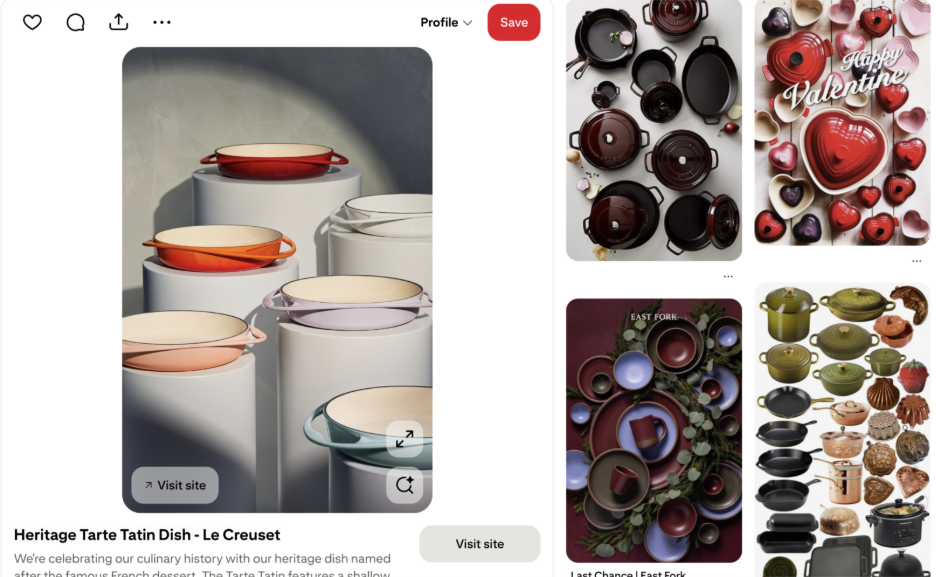
At this point, they’re clicking through. They’re comparing prices, reading descriptions, checking reviews. This is your make-or-break moment.
Merchant move:
Here’s where Rich Pins give you the edge. Think of them as the premium version of a normal pin.
Here’s a clean table you can drop in for that Normal Pin vs. Rich Pin comparison:
Example: IKEA uses Product Rich Pins to showcase full room setups with updated pricing and direct links to every piece. Right now, it’s all about back-to-school and college, they’re pinning seasonally relevant ideas like “The Best Underbed Storage for Dorms”, complete with current prices, availability, and matching products in one click.

This is where months of planning and pinning finally pay off. The customer moves from “one day” to “today”. Whether it happens right on Pinterest through Shopping Pins or after they click through to your site, the goal here is zero friction.
For example,
I searched for “vintage coffee table” and opened a pin featuring a wooden table. Left side of it, Pinterest suggested specific style matching Wayfair and IKEA product posts, but for IKEA the pin included with the brand name, coffee table’s features, and a “visit” button. One click took me straight to IKEA’s product page. That’s exactly how a Shopping Pin works: it bridges inspiration and purchase without breaking the browsing flow.
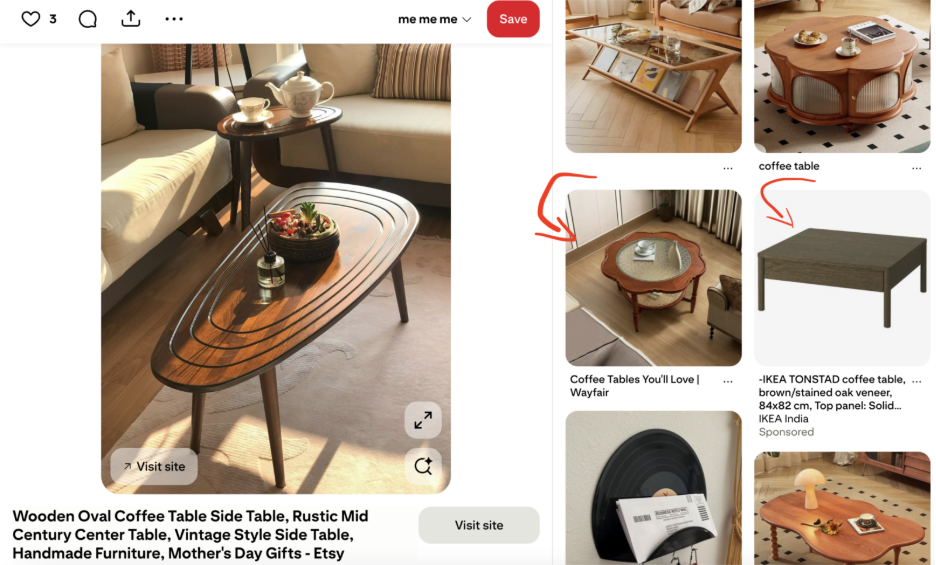
Merchant move:
Alright, now you know the funnel, but here’s the thing: knowing it is one thing, setting yourself up to actually win at every stage is another.
So, let’s start at the very beginning and get your Pinterest foundation right.
Before you post a single pin, you need to set yourself up so every piece of content actually has a shot at converting, otherwise, it’s just pretty wallpaper.
Then, get your product catalog in shape:
Maybe something like,
❌ “#Sofa #LivingRoom #Furniture Sale”
✅ “Velvet 3-Seater Sofa + Comfort with Deep Cushions for Cozy Evenings”
❌ “#WinterCoat #Wool #Fashion”
✅ “100% Wool Coat with Oversized Lapels, Warmth & Style for Cold Days”
We’ve mapped the four stages, Inspiration → Save → Research → Buy already but now let’s zoom out a bit and match them with the content formats.
The easiest way to keep balance? The 3:1 rule: for every 3 inspirational or educational pins, post 1 direct product pin.
Formats with purpose:
Match formats to the buyer journey:
If Step 2 is about what you post, step 3 is about making sure the right people actually see it.
Pinterest works like a visual search engine, which means you can’t just drop a pretty pin and hope for the best, you have to help Pinterest match it to the right searches.
Here’s how to do it without overcomplicating things:
💡 Pro tip: Pinterest SEO doesn’t just work inside Pinterest, well-optimized pins can show up on Google, too. When I searched “vintage coffee machine inspo” on Google, one of the top results was a Pinterest board. The first pin was the perfectly staged espresso machine. That’s how the right keywords and context can get you traffic from two search engines instead of one.
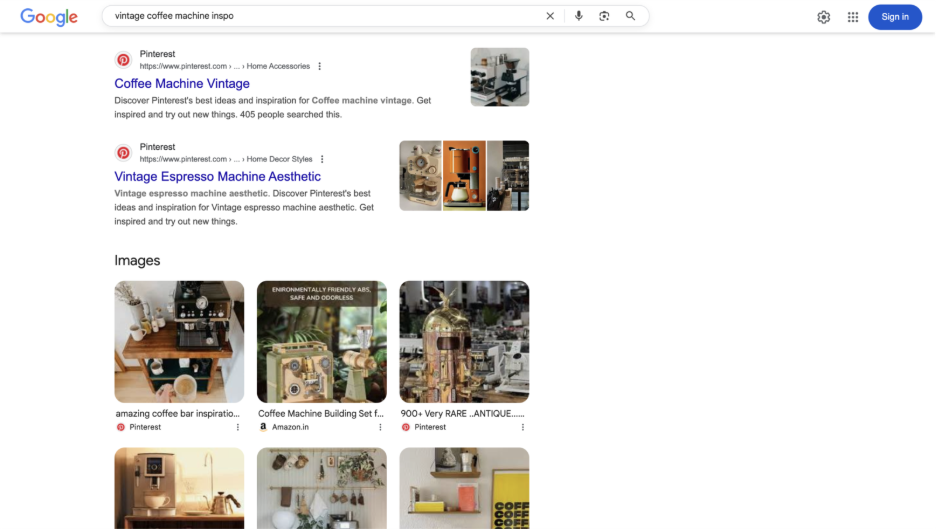
Pinterest ads aren’t there to “go viral””, they’re there to meet people mid-plan. And because Pinners are already in discovery mode, a well-placed ad feels like a shortcut, not an interruption.
First, get in front of the right people
Then: Match your format to your goal
Case in point - PacSun:
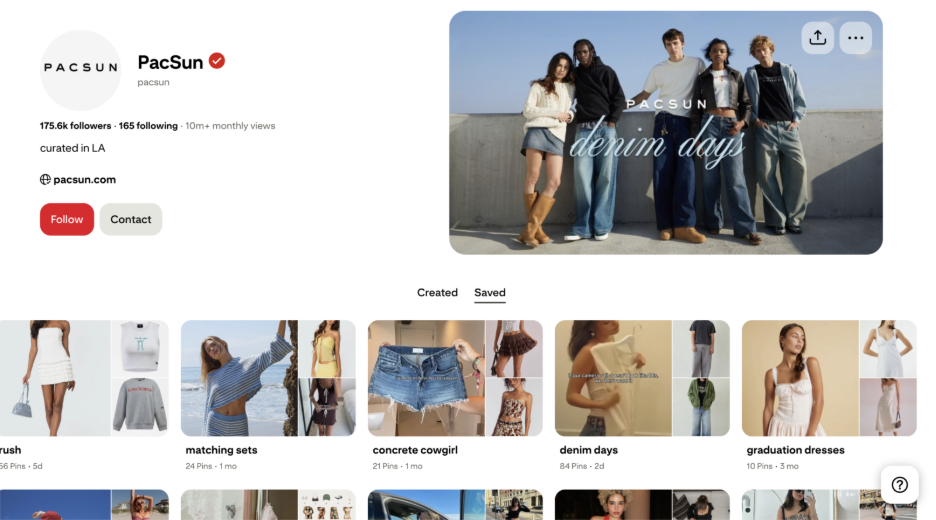
PacSun, is an American retail clothing brand that focuses on youth and teen fashion, especially California-inspired styles. The brand already had the inspo part nailed, using Pinterest trends to push seasonal styles like Back to School and all things pink. But they wanted to turn inspiration seekers into actual buyers. Working with Pinterest, they integrated the Pinterest for Salesforce Commerce Cloud app and Conversions API, making it easier to track what was driving clicks and sales.
Results:
By pairing strong targeting with backend optimization, PacSun turned seasonal style trends into full-funnel performance
Pinterest analytics isn’t just for reporting, you’ll get to know what to post next, what to promote, and what to fix, just like any other platform.
Pinterest can get you the sale, but what you do next turns a one-time buyer into a loyal customer.
A smooth post-purchase experience not only drives repeat sales but also builds the trust that makes your customers introduce their friends to you.
Ways to close the loop:
💡 Pro Tip: Trust builds loyalty, and loyalty builds lifetime value.
📩 Want to make post-purchase protection effortless?
With SureBright, AI powered protection platform you can offer extended warranties and shipping protection with zero extra work on your end.
Contact us, we’ll handle the claims and you keep the trust (and the repeat business).
Finally,
As, Sherlock Holmes said, “It is a capital mistake to theorize before one has data.”
Pinterest is that data. You see what customers are dreaming up before they even know the brand they’ll buy from. Every save, every board, every search is a clue, the kind Holmes would never overlook.
Merchants who treat Pinterest as a pre-commerce platform aren’t just throwing products out there and hoping for the best, they’re moving with evidence, quietly shaping the shortlist while everyone else is still catching up. And when that buying moment finally hits, you don’t want to be the random last-minute option they stumble across, you want to be the choice they’ve been picturing for months.
So tell me, are you going to be part of their plan, or just another tab they close?